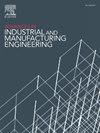SS304应力叠加增量成形中马氏体相变和残余应力发展的调控
IF 6
Q2 ENGINEERING, INDUSTRIAL
Advances in Industrial and Manufacturing Engineering
Pub Date : 2025-03-18
DOI:10.1016/j.aime.2025.100161
引用次数: 0
摘要
应力叠加是金属变形过程中使用的策略之一,可以提高材料的成形性,降低所需的成形力,并创建高度定制的部件。为了研究单点增量成形(SPIF)过程中拉伸和压缩应力的影响,对304不锈钢(SS304)的截形方形金字塔几何形状进行了实验和数值模拟。拉伸应力由定制的液压框架在平面上叠加在试样空白上,压应力通过聚氨酯模具合并。利用SS304的马氏体相变动力学模型中确定的参数,采用两步有限元法预测α′-马氏体体积分数。这些结果与Feritscope在每个金字塔壁四个位置测量的实验结果进行了比较,并通过电子背散射衍射进行了验证。用x射线衍射测量了残余应力。不同增量成形工艺的零件在残余应力和α′-马氏体体积分数上存在差异,这影响了最终的几何形状。应力状态的演变(由应力三轴性和Lode角参数定义)对每个过程的相变变化有贡献。结果表明,在SPIF上叠加拉压应力时,其相变最大,基底附近残余应力最小,整体几何精度最高。应力叠加式增量成形可用于控制最终零件的性能,这对于需要高度定制零件的应用非常理想,例如生物医学创伤固定硬件。本文章由计算机程序翻译,如有差异,请以英文原文为准。
Manipulating martensitic transformation and residual stress development in stress superposed incremental forming of SS304
Stress superposition is one of the strategies used in metal deformation processes to increase the material formability, decrease the required forming forces, and create highly customized components. To investigate the effects of tensile and compressive stresses superposed to the single point incremental forming (SPIF) process, experiments and numerical simulations were conducted for a stainless steel 304 (SS304) truncated square pyramid geometry. Tensile stresses were superposed in-plane on the specimen blank by a custom hydraulic frame, and compressive stresses were incorporated via a polyurethane die. Identified parameters for a martensitic transformation kinetics model for SS304 were used in a two-step finite element approach to predict the ’-martensite volume fraction. These results were compared to experimental results measured by a Feritscope at four locations along each pyramid wall and validated by electron backscatter diffraction. The residual stresses were measured using x-ray diffraction. The parts from each incremental forming process revealed differences in the residual stresses, which impacted the final geometries, and the ’-martensite volume fraction at the four measurement locations. The evolution of the stress state, defined by the stress triaxiality and Lode angle parameter, for each process contributed to the phase transformation variance. It was found that superposing both tensile and compressive stresses to SPIF resulted in the greatest phase transformation and lowest magnitude of residual stresses near the base and the greatest overall geometrical accuracy. Stress-superposed incremental forming can be implemented to manipulate final part properties, which is ideal for applications requiring highly customized parts, e.g., biomedical trauma fixation hardware.
求助全文
通过发布文献求助,成功后即可免费获取论文全文。
去求助
来源期刊

Advances in Industrial and Manufacturing Engineering
Engineering-Engineering (miscellaneous)
CiteScore
6.60
自引率
0.00%
发文量
31
审稿时长
18 days
 求助内容:
求助内容: 应助结果提醒方式:
应助结果提醒方式:


